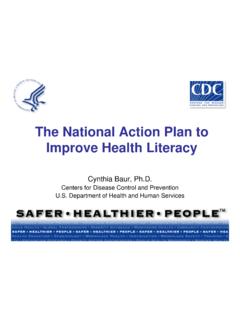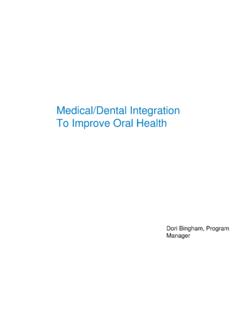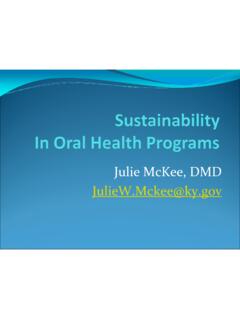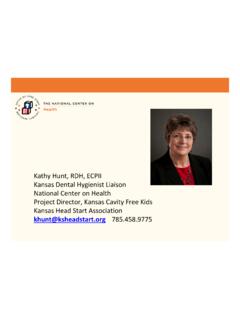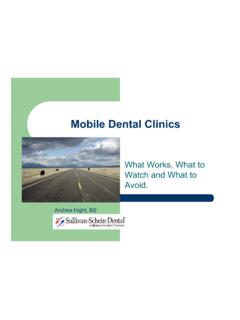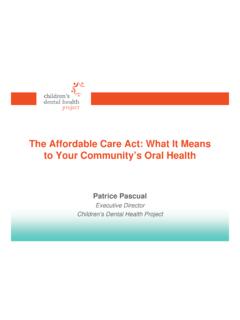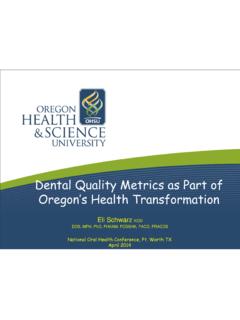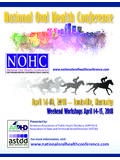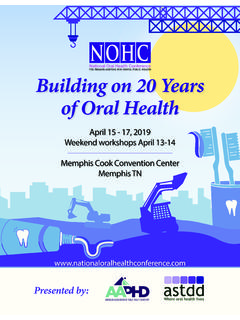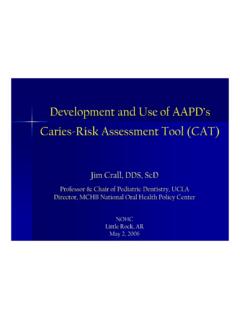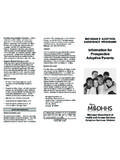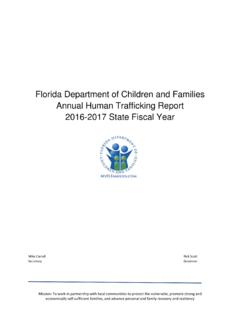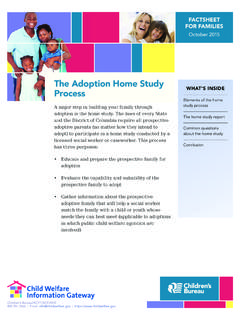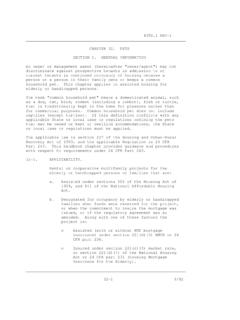Transcription of Understanding the FQHC Prospective Payment System
1 Understanding the FQHCP rospective Payment SystemMARY E. FOLEY, MPHE xecutive DirectorMedicaid-CHIP State Dental Association2013 National Oral Health ConferenceApril 2013 Federally Qualified Health Centers National network of community health centers Supported by the Health Resources and Services Administration (HRSA); BPHC Provide culturally competent comprehensive primary health care services including dental Provide enabling services interpretation and transportation Federally Qualified Health Centers Health Resources and Services Administration; Types of FQHCs Community Health Centers Migrant Health Centers Focus on primary healthcare needs of migrant and seasonal agricultural workers and their families .
2 Currently 156 MHC across the states In 2010, MHC served >800,000 patients Healthcare for the Homeless Centers Public Housing Primary Care Centers located within or adjacent to public housing developments and serve the residential communityCharge To serve vulnerable populations and medically underserved communities FQHC Target Population Serves millions- vulnerable populations and medically underserved Low income populations The uninsured Those with limited English proficiency Migrant and seasonal farm workers Individuals and families experiencing homelessness Those living in public housingFQHC Locations High need communities Health Professional Shortage Areas (HPSA) Dental HPSA Governed by a representative community board Provide comprehensive primary health careservices including dental Offer an array of supplemental family support services such as interpretation and transportation.
3 Funding Support FQHC s receive federal grants for operational cost Maximize resources through reimbursement from all third parties Use a corresponding schedule of discounts on the basis of the patient ability to pay Multiple models for Payment -fee schedules The Medicaid Program- Public Payer of Healthcare Services Federal entitlement program Enacted in 1965 under Title XIX of the Social Security Act Jointly administrated by federal and state governments Charged with implementing the EPSDT program. Pays for medically necessary services, including dental care, for enrollees those individuals who meet specific age, health and incomeeligibility requirements. All states participate in the Medicaid program Wide variability exists in coverage across the states There are core eligibility requirements set by the federal government States have flexibility to increase lower threshold limits to cover additional low-income beneficiaries Across states, eligibility, benefits and Payment for services vary depending upon specific criteria set by each state Medicaid agency.
4 The Medicaid Program- Public Payer of Healthcare Services All states participate in the Medicaid program Wide variability exists in coverage across the states There are core eligibility requirements set by the federal government States have flexibility to increase lower threshold limits to cover additional low-income beneficiaries Across states, eligibility, benefits and Payment for services vary depending upon specific criteria set by each state Medicaid agency. Children s Health Insurance ProgramPublic Payer of Healthcare Services Federal-state medical assistance program Enacted in 1997 Pays for health care services, including dental care, for children whose family s income is slightly higher than those eligible for Medicaid CHIP defines the dental benefit as those services necessary to prevent disease and promote health, restore oral structures to health and function, and treat emergency conditions.
5 FQHC Payment ModelsFee For Service Payment model where fees are designated for individual services. FFS is the dominant Payment method for dental care in the United States. These Payment plans often impose a copayment, annual deductibles and apply benefit limitations. It is also the model traditionally usedby state Medicaid agencies to pay Medicaid dentist providers. This model is used by some FQHC. Managed Care Payment model that uses a variety of strategies to reduce healthcare costs and improve the quality of services. Many state Medicaid agencies are beginning to contract with managed care organizations (MCOs) and Health Maintenance Organizations (HMOs) to manage all or part of their dental benefits program.
6 Under a state Medicaid -managed care contract, the state pays the MCO Contracts vary widely, MCO may wholly or in-part administer the dental program; establish a network of providers; coordinate care; and manage the Payment for services rendered. Prospective Payment System (PPS) Primary method of Payment for services provided by FQHCs Reimbursement method where Medicaid payments for healthcare services, including dental care, are made based on a predetermined fixed amount. Fixed amount is established and updated as necessary based on a formula and the actual costs of services. The CHC will generally know the method and amount paid by Medicaid in their state. Payment Systems Source of Key Information Payment systems provide key information CMS Form-416 12a-12g Program services-> access Specific utilization-> use of services Quality assessment Quality improvement Program managers, HMOs, MCOs and TPAsState FQHCs Payment Models Variability Across States Snapshot of State programsFQHC Reimbursement MethodologyDoes state receive CDT level information from claims submitted by FQHCs?
7 State and Regional ComparisonsFQHC Payment Methodologies FQHC Payment Methodology by State FQHC Payment Methodology by State Does state include CDT level data on annual CMS-Form 416 Report?Does state include CDT level data on annual CARTS Report?States that Collect CDT Level Data States that Collect CDT Level Data Contact InformationMary E. Foley, RDH, MPHE xecutive DirectorMedicaid-CHIPS State Dental Association4411 Connecticut Ave. NW, Suite 104 Washington DC Program Impact through Innovation and Leadership: Preparing for 2014 June 2th-4th, 2013 Washington Marriott Wardman ParkWashington DC National Medicaid and CHIP Oral Health Symposium
